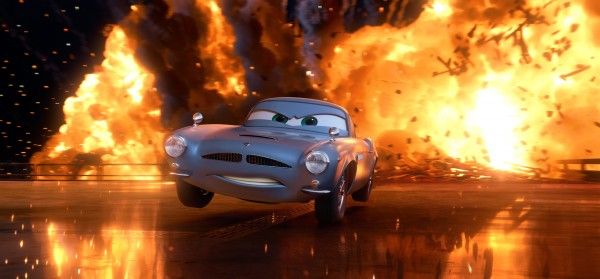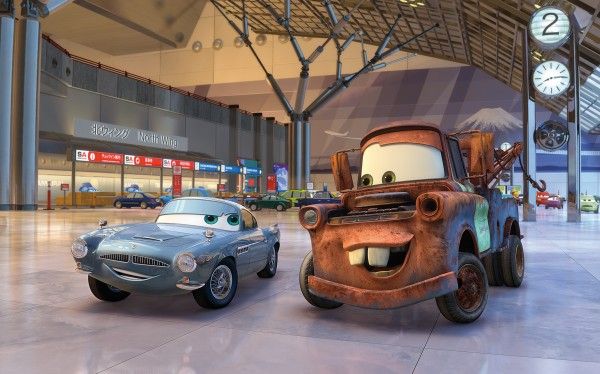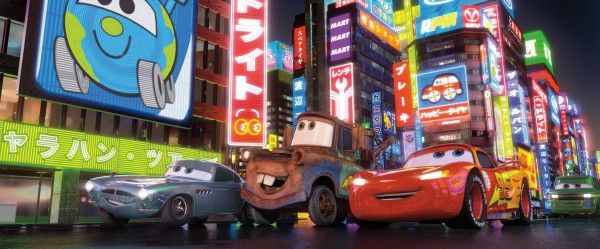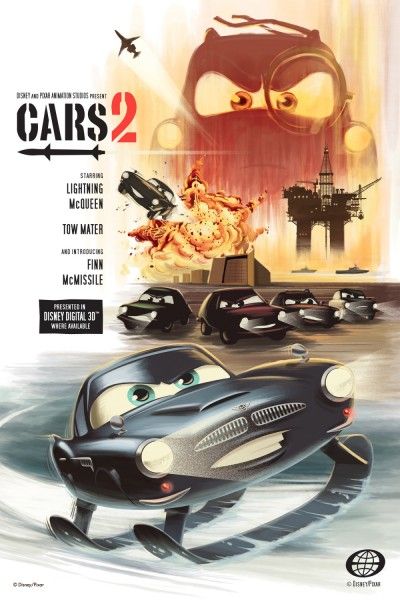In anticipation of the release of Cars 2 on June 24th, we were invited to the press day for the film at Pixar a while ago. During our time at the studio, we got the chance to sit down with director/Pixar guru John Lasseter. Currently the chief creative officer at Pixar and Walt Disney Animation Studios, as well as the Principal Creative Advisor for Walt Disney Imagineering, Lasseter was one of the founding talents behind Pixar. He personally directed the studio’s first three films (Toy Story, A Bug’s Life and Toy Story 2), as well as 2006’s Cars.During our interview, Lasseter talked about his approach to the sequel, what influences they had on the film, what challenges they encountered throughout production, what to expect from the next Pixar film Brave, and the future of the studio. Hit the jump to check it out.First off, if you’ve missed any of our previous Cars 2 interviews here’s your chance to catch up:
- Producer Denise Ream
- Composer Michael Giacchino
- Story Supervisor Nathan Stanton
- Supervising Animators Shawn Krause and Dave Mullins
- Emily Mortimer, the voice of Holly Shiftwell
Lasseter was running short on time when we began our interview, but he was extremely gracious and ended up talking for quite a bit. We’d been hearing from all the other creatives and actors involved with the film how obsessed Lasseter was with these characters, and his passion for all things Cars was extremely evident. It just goes to show that Pixar never half-asses anything. These people have an incredible drive and desire to tell the best stories possible.
Beware, a few SPOILERS regarding the overall plot of Cars 2 lie below. If you’d rather go into the film knowing as little as possible, it may be best to check out the interview after you catch the film.
In case you don’t get the chance to read the full interview, here are a few highlights:
- Originally, the film was set to open in Prague, but Lasseter decided that he wanted to open the film in a way that no one would expect. He was influenced by other spy movies, wherein the opening scene usually has a big action set-piece, but the audience has no idea what it’s about.
- When crafting the villain, Lasseter was influenced by hyper-smart villains. He wanted a villain where, at the end of the movie when you find out what they’re about, it makes perfect sense from their point of view.
- He thought Big Oil would make for a great villain in Cars 2, given the surge in alternative fuels right now.
- Brave is set in medieval Scotland, and some of the technological challenges in that film include animals, people with lots of layers of clothes, hair, sword-fights, arrows and mystical forests.
- The scale of Cars 2 was one of the biggest challenges. The level of detail in the film is about 10-times more than any other Pixar film. It’s the biggest film Pixar has ever done.
- The water in Cars 2 was created using all-new technology.
I really loved the beginning of the film, I’m a big Bourne fan and I can see how that influence worked its way in. But how did you decide to open the film the way you did instead of beginning in Prague as was originally intended?
John Lasseter: When you really study espionage movies, or spy movies, the beginnings are really set up to have like an amazing bit of action, but at the moment you’re watching it you have no idea why or what it’s about. But in the end, it sort of sets up the conspiracy, sets up the bad guy story, sets up what the movie’s kind of about in some way or gets things going. And I had a strong desire to start Cars 2 out as far away from what you would expect to find in a sequel to Cars. Everybody’s expecting Lightning McQueen, Mater, NASCAR racing, Radiator Springs, and the first thing you see is a boat out in the middle of the ocean. And a car on a boat, that’s looking for a car. I just loved that notion of taking it as far away as you can from it. It also sets up sort of the gigantic oil platforms, and all that’s there. I just thought it was a really really interesting set piece, that it could be so different from the original.
When you think of great classic spy movie villains, names like Goldfinger come to mind. Were there specific influences on your villain for this film?
Lasseter: You know the specific influences on villains to me is, I love the villains who are really hyper-smart. When at the end of the movie you find out what they were about, and it makes absolutely perfect sense from their point of view. There’s a term that you use it’s called “the center of good,†they’re doing the right thing, sometimes just for pure greed, but it’s like they’re so far ahead of everybody else. And that’s what the spy, the good guys, is always trying to figure out this game that’s been set up, and get deeper and deeper and deeper. And I think that’s what was so exciting about this, is what could the bad guys desire be? Who would be a good bad guy in this world? And I kept thinking, in the world of Cars I think Big Oil could be an awesome bad guy. It was interesting, because while we were working so hard on the story the oil platform disaster in the gulf happened and it was so interesting to see how that all played out—we had nothing to do with that by the way (laughs). We had already set on opening on an oil platform and I kept looking around like “I can’t believe this.†But it’s that notion of, me being here in California where everybody is—you know I have solar panels, I’ve taken my house off the grid, I’m in line for one of these new electric cars, and all this kind of stuff you know we’re just so focused on alternative fuels and “Why can’t we have alternative fuels now?!†And I started thinking, it’d be awesome to have Big Oil so scared of alternative fuels that they try to undermine it and give it a bad reputation on a world stage, and I thought this could be something that could be a really interesting subject of the conspiracy and the bad guy. Because it’s sort of a little bit set in what’s going on right now. And part of that is, it’s not a message film, it’s just making it believable for today’s audiences.
I love how it’s partly a love letter to Japan and Japanese culture and everything. The events that have recently happened are so unfortunate; do you plan on doing anything around the release?
Lasseter: Well I’m so proud of the film, and it is a true deep love letter to Japan. And I’m so happy that we’ve made it this way, it’s really special. Because I’ve been there so many times, and I really really love that country. My heart just breaks like the rest of us for what’s happened there, so I’m so excited for them to see this, and to see that it’s a real love letter for that. It’s the same, frankly, for each of the countries that we go to: Paris, Italy, England. I just have been there so many times and I love each of these places. That’s why I’m so excited about this film, because it’s bigger than any Pixar film that’s been made. It’s really vast, as far as the places that they go to and how big these places are.
Each Pixar film just keeps looking better and better. From what we saw today, the lights and everything in Tokyo were absolutely stunning. And all the concept art for Brave looks fantastic. What’s the next frontier? What’s next?
Lasseter: It’s just gonna keep going. Frankly, from Toy Story on I’ve gotten that exact same question. What’s so exciting is where our tools are gives us as artists the ability to do more and more and what’s in our mind and what we can conceive. The next film we have going is a big challenge for us. It’s called Brave, where the main character is a woman. It’s set in medieval Scotland, where there’s animals and people with lots of layers of clothes, and hair and sword-fights and arrows, and mystical magical forests and all this stuff that’s very exciting, and it’s someplace we’ve never been before. And I think that’s gonna present all new challenges for us, and then as we kind of go on to the sequel to Monsters Inc., and all the things that that will be, and taking that world to a new place. It’s so much fun because it’s really—you know there’s no Holy Grail. The Holy Grail is making great stories. And the technology is always there in the service of telling these stories, and every story we tell has requirements that we just don’t know how to do. In the case of Cars 2, the whole notion of the movie and the genre of going to all these places, but we just don’t go to one location within that place. You feel like you’ve seen all of Tokyo, you see all of Paris, you see all of the Italian Riviera, you go to London and drive all over London, fly all over London. It’s just remarkable, the vast scale of this film. But also it’s things like the water, it’s all new technology. That is brand new, water’s never looked like that in a computer-animated film. And we’ve got this amazing lighting that just takes it to another level. It’s very exciting. The level of detail in this film is probably 10-times more than any Pixar film, and the more you look the more stuff you’ll see. I love putting detail in films, and this one’s got a lot. Really I always knew that the setting is almost a character in the film, it’s so much a part of the story, so much a part of the reinforcing of McQueen and Mater’s storyline, but it’s also a huge part of the entertainment.
And just yesterday it was reported that Dan Scanlon is directing the Monsters Inc. prequel, could you confirm that?
Lasseter: Yes. Dan Scanlon is directing Monsters University! And Kori Rae is producing. Yeah, we’re very excited.




